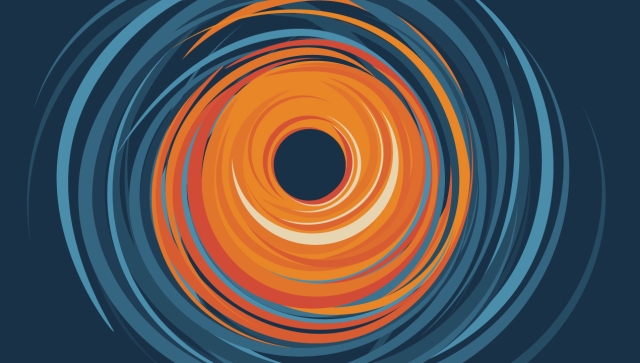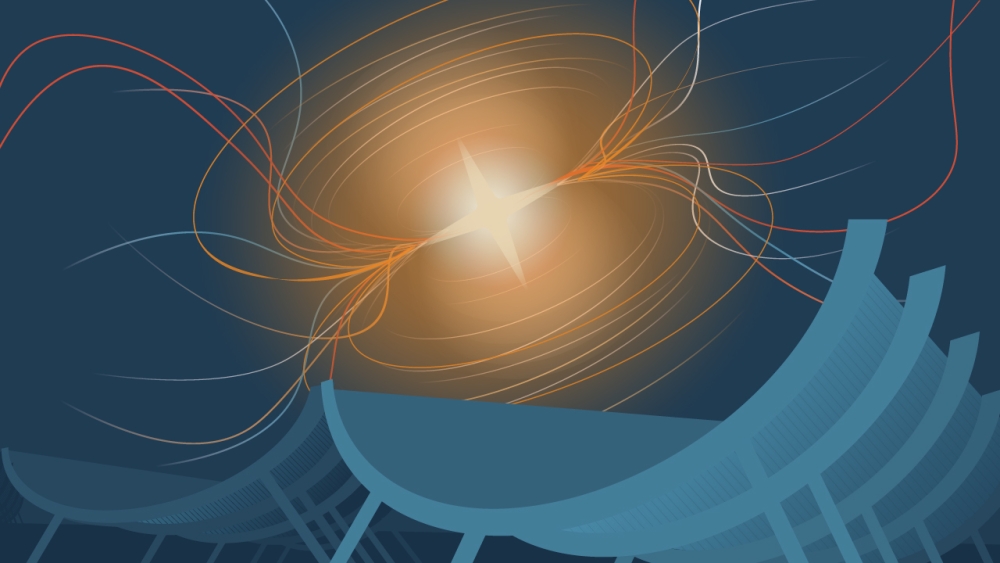
Probing hydrogen intensity and fast radio bursts with CHIME and CHORD
In 2017, the Canadian Hydrogen Intensity Mapping Experiment (CHIME) came online for the first time. The goal: map the abundance of hydrogen in the universe, and use that information to independently measure the universe’s expansion rate. But CHIME has also proved to be a powerful tool for detecting transient events in the night sky, like mysterious ‘fast radio bursts (FRBs)’ – powerful, short signals first discovered in 2007. CHIME has now found more than 4,000 FRBs, while all other telescopes combined have found ~300.
CHIME’s success comes in part because of its design philosophy, which moves the complexity of the instrument from the hardware to the software. The algorithms CHIME uses to search through the masses of data it collects are unmatched, and Perimeter scientists have been deeply involved in designing and coding that software.
Daniel Family James Peebles Chair in Theoretical Physics, Kendrick Smith, as well as associate faculty Ue-Li Pen, Computational Scientist Dustin Lang, Research Scientist Seth Siegel, and postdoctoral researcher Simon Foreman have all contributed.
The team has also been involved in producing key science results emerging from CHIME, including the discovery of new repeating FRBs that hint at the origin of the signals, and finding the first FRB within our own galaxy, whose point of origin could be precisely determined. These discoveries suggest magnetars – highly magnetized neutron stars – are the likely origin of most FRBs, although the exact physics of this process is not yet understood, and other sources may exist.
Perimeter and its scientists are also a core partner in CHIME’s upcoming successor, the Canadian Hydrogen Observatory and Radio-transient Detector (CHORD), a 512-dish array that will have 10 times the sensitivity of CHIME. With construction underway, CHORD is expected to put new constraints on dark energy, and outmatch CHIME in its ability to localize the points of origin of new FRBs.
The CHIME/FRB Collaboration, “A bright millisecond-duration radio burst from a Galactic magnetar.” Nature volume 587, pages 54–58 (2020).;
The CHIME/FRB Collaboration, “Sub-second periodicity in a fast radio burst.” Nature volume 607, pages 256–259 (2022).;
K. Vanderlinde et al. “LRP 2020 Whitepaper: The Canadian Hydrogen Observatory and Radio-transient Detector (CHORD).” arXiv:1911.01777.

Devising new ways to test primordial non-Gaussianity
The early universe, as far as we can tell, was a strikingly simple place. The cosmos emerged from the hot big bang in an almost perfectly flat, homogeneous state. The primordial density variations appear to have had a uniform composition, and near-perfect Gaussianity – that is to say, the fluctuations, when plotted on a graph, match a perfectly normal distribution: a bell curve.
The universe’s simplicity presents a challenge to fundamental physics, because there is no straightforward explanation for how that homogenous early universe evolved into what we see today. We must either find a compelling explanation for this simplicity, or discover new observational clues going beyond the simplicity. Measuring the extent of non-Gaussianity (if there is any) would help refine possible models of the universe and improve our understanding of the period of cosmic inflation.
Perimeter researchers have been primary drivers of this research, approaching it from several angles. Neal Dalal (at the time a senior research associate at the Canadian Institute for Theoretical Astrophysics, and later a Perimeter faculty member) proposed a new test for non-Gaussianity in 2008, by measuring the clustering of galaxies in the universe. This idea was further developed by Perimeter visiting fellow Sarah Shandera. Their approach overcame a challenge known as scale-dependant galaxy bias, in which different sizes of galaxies clump together differently, making it complicated to track the evolution of the cosmic web in a simplistic way.
Meanwhile, Kendrick Smith, Daniel Family James Peebles Chair in Theoretical Physics, along with Perimeter Distinguished Visiting Research Chair Matias Zaldarriaga and their colleague Leonardo Senatore, advanced the development of new statistical methods required to test for non-Gaussianity using observations of the Cosmic Microwave Background (CMB) radiation taken by the WMAP and Planck experiments. The CMB is the remains of the first light to travel freely through the universe, about 380,000 years after the big bang. Their analyses show, with unprecedented precision, that our cosmological initial conditions seem to have been perfectly Gaussian, with no hint of primordial non-Gaussianity so far. These results represent a huge step forward in the precision measurement of the early universe, and provide a fundamental new constraint in theoretical cosmology.
More recently, Perimeter researchers have developed a completely novel way to test for non-Gaussianity, using what is known as the kinetic Sunyaev-Zeldovich (kSZ) effect: the Doppler shifting of CMB photons produced by scattering off ionized electrons in the late universe. Existing statistical methods were not powerful enough to disentangle different physical effects in the kSZ, but the Perimeter team, including Smith, research associate faculty Matthew Johnson, and postdoctoral researchers Matthew Madhavacheril, Moritz Münchmeyer, and Zheng Pan, developed new methods, enabling them to extract cosmological signals from kSZ. The first applications of these methods to real data were carried out by Johnson, Smith, and collaborators. These new kSZ statistical methods will be instrumental in probing data from the next major observation of the CMB, expected to come from the Simons Observatory, which began taking data in 2024, and are increasingly being adopted in cosmological data analysis. There has been a significant uptake in these methods across the scientific community.
Neal Dalal, Olivier Doré, Dragan Huterer, and Alexander Shirokov, “Imprints of primordial non-Gaussianities on large-scale structure: Scale-dependent bias and abundance of virialized objects.” Phys. Rev. D 77, 123514 (2008).;
Marilena LoVerde, Amber Miller, Sarah Shandera and Licia Verde, “Effects of scale-dependent non-Gaussianity on cosmological structures.” JCAP 014 (2008).;
K. Smith, L. Senatore and M. Zaldarriaga, “Optimal Analysis of the CMB trispectrum,” arXiv: 1502.00635.;
K. Smith et al., “Planck 2015 Results. XVII. Constraints on primordial non-Gaussianity,” arXiv: 1502.01592.;
K. Smith, S. Ferraro, “Detecting patchy reionization in the CMB,” Phys. Rev. Lett. 119 (2017) 021301, [arXiv:1607.01769].;
M. Münchmeyer, M. Madhavacheril, S. Ferraro, M. Johnson, K. Smith, “Constraining local non-Gaussianities with kSZ tomography,” Phys. Rev. D 100 (2019) 083508, [arXiv:1810.13424].;
Z. Pan, M. Johnson, “Forecasted constraints on modified gravity from Sunyaev-Zeldovich tomography,” Phys. Rev. D 100 (2019) 0803522, [arXiv:1906.04208]. A. Deutsch, E. Dimastrogiovanni, M. Johnson, M. Münchmeyer and A. Terrana, “Reconstruction of the remote dipole and quadrupole fields from the kinetic Sunyaev Zel’dovich and polarized Sunyaev Zel’dovich effects,” Phys. Rev. D 98 (2018) 123501, [1707.08129 [astro-ph.CO]].;
Cayuso, M. Johnson and J. Mertens, “Simulated reconstruction of the remote dipole field using the kinetic Sunyaev Zel’dovich effect,” Phys. Rev. D 98 (2018) 063502, [1806.01290 [astro-ph.CO]].;
K. Smith, M. Madhavacheril, M. Münchmeyer, S. Ferraro, U. Giri and M. Johnson, “KSZ tomography and the bispectrum,” [1810.13423 [astro-ph.CO]].;
Utkarsh Giri and Kendrick M. Smith, “Exploring KSZ velocity reconstruction with N-body simulations and the halo model,” J. Cosmol. Astropart. Phys. 2022 (2022) 028, [2010.07193 [astro-ph.CO]].;
Selim C. Hotinli, Simone Ferraro, Gilbert P. Holder, Matthew C. Johnson, Marc Kamionkowski and Paul La Plante, “Probing helium reionization with kinetic Sunyaev Zel’dovich tomography.” [2207.07660 [astro-ph.CO]].;
Selim C. Hotinli, Joel Meyers, Neal Dalal and Andrew H. Jaffe et al., “Transverse velocities with the moving lens effect,” Phys. Rev. Lett. 123 (2019) 061301, [1812.03167 [astro-ph.CO]].;
Selim C. Hotinli, Kendrick M. Smith, Mathew S. Madhavacheril and Marc Kamionkowski, “Cosmology with the moving lens effect,” Phys. Rev. D 104 (2021) 083529, [2108.02207 [astro-ph.CO]].;
Selim C. Hotinli, Gilbert P. Holder, Matthew C. Johnson and Marc Kamionkowski, “Cosmology from the kinetic polarized Sunyaev Zel’dovich effect,” J. Cosmol. Astropart. Phys. 2022 (2022) 026, [2204.12503 [astro-ph.CO]].;
Oliver H.E. Philcox and Matthew C. Johnson, “Novel cosmological tests from combining galaxy lensing and the polarized Sunyaev Zel’dovich effect.” Phys. Rev. D 106 (2022) 083501, [2206.07054 [astro-ph.CO]].;
Richard Bloch, Matthew C. Johnson, “Kinetic Sunyaev Zel'dovich velocity reconstruction from Planck and unwise,” 2024, arxiv.org/abs/2405.00809.;
Fiona McCarthy et al., “The Atacama Cosmology Telescope: Large-scale velocity reconstruction with the kinematic Sunyaev Zel'dovich effect and DESI LRGs.” JCAP 057 (2025).;
Alex Laguë, Mathew S. Madhavacheril, Kendrick M. Smith, Simone Ferraro, Emmanuel Schaan, “Constraints on Local Primordial Non-Gaussianity with 3D Velocity Reconstruction from the Kinetic Sunyaev-Zeldovich Effect,” Phys.Rev.Lett. 134 (2025) 15, 151003.
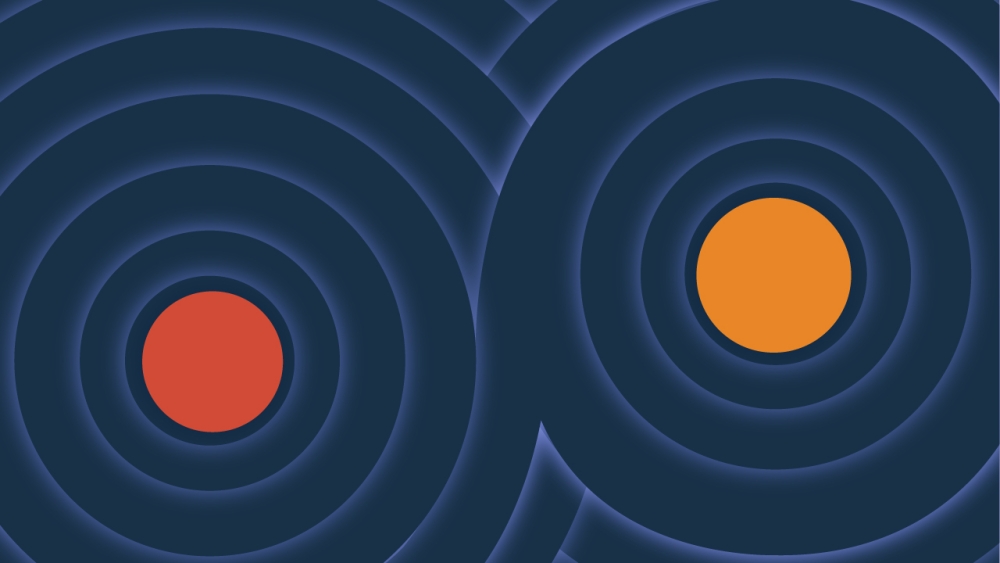
Probing gravity and dark energy
Einstein’s general relativity (GR) has been a very successful theory of gravity, as tested within the Solar System and in measurements using pulsar signals. However, when astronomers try to reconcile it with cosmological observations, they are forced to invoke two mysterious energy components – dark matter and dark energy. These have only been detected gravitationally, yet they make up most of the energy and matter in the cosmos. In a related problem, quantum mechanics suggests the existence of vacuum energy – the result of ‘virtual particles’ that constantly emerge and annihilate, popping in and out of existence as particle-antiparticle pairs. This vacuum energy is one possible explanation for dark energy, but the predictions of its strength made by quantum mechanics, and the observed strength in the cosmos, are wildly different. It’s a conundrum called the cosmological constant problem.
This situation might be a clue that GR is not quite correct on large scales and must be modified in some way to resolve these conundrums. Modifications of GR that are theoretically and observationally consistent, however, are surprisingly hard to find.
One promising modification of GR suggests that the graviton (a theoretical particle that mediates the gravitational force) has mass. The idea of ‘massive gravity’ goes all the way back to 1939, when it was theorized by Markus Fierz and Wolfgang Pauli, but their version was incomplete.
Some important work in developing a full theory of massive gravity came from Perimeter faculty member Justin Khoury. A major breakthrough followed in 2011, when Claudia de Rham and Andrew Tolley (together with Gregory Gabadadze) built off their postdoctoral research at Perimeter to develop a non-linear completion of Fierz and Pauli’s 1939 linearized theory. This was the first truly complete theory of massive gravity.
Massive gravity implies that gravitational waves must travel below the speed of light, offering the potential for future observational tests of the theory. Current gravitational wave detectors would need improved sensitivity to either confirm or rule out this possibility.
Massive gravity’s predictions match the observations of GR in the near universe, but modify it at large distances, and it could explain the accelerated expansion of the universe without the need for dark energy. This was a landmark result, and research building on this theory has continued to progress.
More recently, observational evidence is growing that dark energy may be dynamical and evolving over time. Perimeter research associate faculty Will Percival and computational scientist Dustin Lang are core members of the Dark Energy Spectroscopic Instrument (DESI) collaboration, which released the first hints of the dynamical nature of dark energy in 2024, and followed up in 2025 with more data. DESI’s science run is ongoing. Its outcomes will drive new work on both theoretical and observational efforts to find a complete explanation for dark energy, the cosmological constant problem, and gravity.
Gia Dvali, Stefan Hofmann, and Justin Khoury, “Degravitation of the cosmological constant and graviton width,” Phys. Rev. D 76, 084006.;
Claudia de Rham, Gregory Gabadadze, Andrew J. Tolley, “Resummation of Massive Gravity,” Phys.Rev.Lett.106:231101,2011, DESI Collaboration, “DESI 2024 III: Baryon Acoustic Oscillations from Galaxies and Quasars.” arXiv:2404.03000.;
DESI Collaboration, DESI Collaboration, “DESI 2024 VI: Cosmological Constraints from the Measurements of Baryon Acoustic Oscillations” https://arxiv.org/abs/2404.03001;
DESI Collaboration, “DESI 2024 VI: Cosmological Constraints from the Measurements of Baryon Acoustic Oscillations.” https://arxiv.org/abs/2404.03002.;
DESI Collaboration, “DESI DR2 Results II: Measurements of Baryon Acoustic Oscillations and Cosmological Constraints.” https://arxiv.org/abs/2503.14738.
More Turning Points:
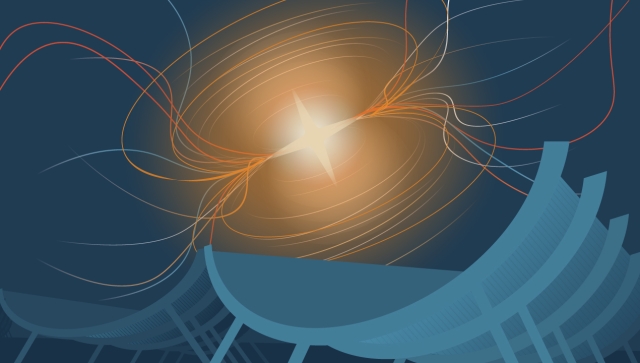
Cosmology

Mathematical Physics
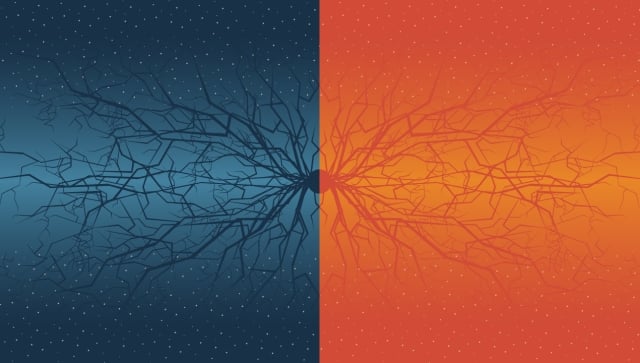
Particle Physics

Quantum Foundations
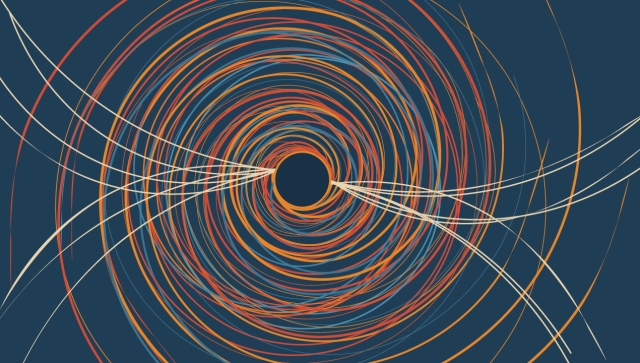
Quantum Fields and Strings

Quantum Gravity
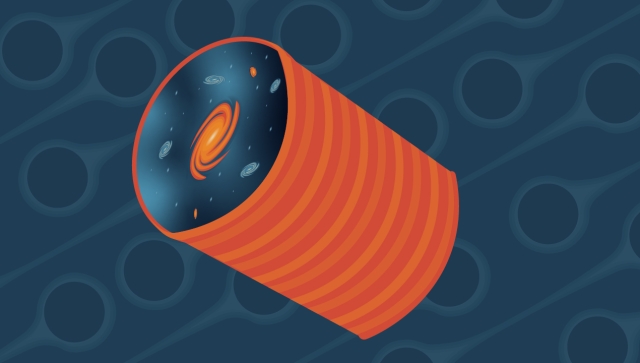
Quantum Information

Quantum Matter
